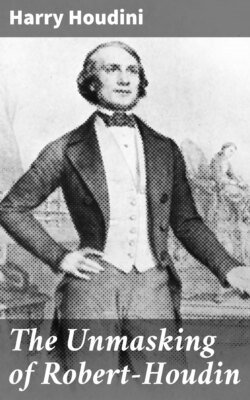Читать книгу The Unmasking of Robert-Houdin - Harry Houdini - Страница 5
На сайте Литреса книга снята с продажи.
CHAPTER I
SIGNIFICANT EVENTS IN THE LIFE OF ROBERT-HOUDIN
ОглавлениеTable of Contents
ROBERT-HOUDIN was born in Blois, France, December 6th, 1805. His real name was Jean-Eugene Robert, and his father was Prosper Robert, a watchmaker in moderate circumstances. His mother’s maiden name was Marie Catherine Guillon. His first wife was Josephe Cecile Eglantine Houdin, whose family name he assumed for business reasons. He was married the second time to Françoise Marguerite Olympe Naconnier. His death, caused by pneumonia, occurred at St. Gervais, France, on June 13th, 1871.
Jean-Eugene Robert-Houdin. Photograph taken—about 1868. From the Harry Houdini Collection.
Barring the above facts, which were gleaned from the register of the civil authorities of St. Gervais, all information regarding his life previous to his first public appearance in 1844 must be drawn from his own works, particularly from his autobiography, published in the form of “Memoirs.” Because of his supreme egotism, his obvious desire to make his autobiography picturesque and interesting rather than historically correct, and his utter indifference to dates, exact names of places, theatres, books, etc., it is extremely hard to present logical and consistent statements regarding his life. Such discrepancies arise as the mention of three children in one chapter and four in another, while he does not give the names of either wife, though he admits his obligation to both good women.
According to his autobiography, Jean-Eugene Robert was sent to college at Orleans at the tender age of eleven, and remained there until he was eighteen. He was then placed in a notary’s office to study law, but his mechanical tastes led him back to his father’s trade, watchmaking. While working for his cousin at Blois, he visited a bookshop in search of Berthoud’s “Treatise on Clockmaking,” but by mistake he was given several volumes of an old encyclopædia, one of which contained a dissertation on “Scientific Amusements,” or an exposition of magic. This simple incident, he asserts, changed the entire current of his life. At eighteen, he first turned his attention to magic. At forty, he made his first appearance as an independent magician or public performer.
On page 44 of his “Memoirs,” American edition, Robert-Houdin refers to this book as an encyclopædia, but several times later he calls it “White Magic.” In all probability it was the famous work by Henri Decremps in five volumes, known as “La Magie Banche Dévoilée,” or “White Magic Exposed.” This was written by Decremps to injure Pinetti, and it exposed all the latter’s tricks, including the orange tree, the vaulting trapeze automaton, and in fact the majority of the tricks later claimed by Robert-Houdin as his own inventions.
In 1828, while working for M. Noriet, a watchmaker in Tours, Jean-Eugene Robert was poisoned by improperly prepared food, and in his delirium started for his old home in Blois. He was picked up on the roadside by Torrini, a travelling magician, who nursed him back to health in his portable theatre. Just as young Jean recovered Torrini was injured in an accident, and his erstwhile patient remained to nurse his benefactor and later to help Torrini’s assistant present the programme of magic by which they made their living. His first public appearance as the representative of Torrini was made at Aubusson.
The only Robert-Houdin poster showing his complete stage setting. This lithograph was made in France. From the Harry Houdini Collection.
Programme for the opening of Robert-Houdin’s theatre in Paris. Reproduced from the American edition of his “Memoirs."
Robert-Houdin’s favorite lithograph for advertising purposes. Used on the majority of his posters and in the original edition of his “Memoirs.” From the Harry Houdini Collection.
Torrini was an Italian whose real name was Count Edmond de Grisy. He was a contemporary of Pinetti. In all probability, during the long summer of their intimate companionship, Torrini not only initiated his fascinated young guest into his own methods of performingtricks, but also into the secrets of Pinetti’s tricks. In his “Memoirs,” Robert-Houdin makes no secret of the fact that both Comus and Pinetti, together with their tricks, were topics of conversation between himself and Torrini.
A very rare, and possibly the only, programme in existence, chronicling Robert-Houdin’s first appearance before Queen Victoria, July 19th, 1848. The original, now in the Harry Houdini Collection, was presented to James Savren by Robert-Houdin.
